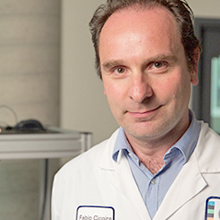Department of Chemical Engineering
Materials science and technology Thin films/interfaces Polymer chemistry Surface and interfacial chemistry Electrochemistry Advanced manufacturing
Innovative Materials
Research interests and affiliations
|
Description de la recherche
Self-healing electronic materials Self-healing electronic materials can find applications in wearables, stretchable and bendable electronics, as well as in artificial electronic skin. A major challenge for these materials is to combine fast and reproducible healing characteristics, high conductivity and, in the case of applications for electronic skin, biocompatibility. We were the first to report water-induced healing of films of the conducting polymer poly (3,4) ethylenedioxythiophene doped with polystyrene sulphonate (PEDOT:PSS). The healing process took place within an extremely short time (about 150 milliseconds) and enabled complete restoration of the initial film conductivity, even after multiple damages. Successively, we showed that films processed from mixtures of PEDOT:PSS and polyethylene glycol (PEG) exhibit repeatable autonomic self-healing. We found that the addition of PEG decreases the Young’s modulus and increases the elongation at break of PEDOT:PSS films, thus leading to a softer material. The self-healing can be switched from autonomic to water-enabled by varying the PEG amount in the film, the molecular weight of PEG or by soaking PEG-containing films in methanol. We studied the water-enabled self-healing of the following systems: PEDOT:PSS films processed in presence of the crosslinker 3-(glycidyloxypropyl)trimethoxysilane; PEDOT:PSS films post-treated with sulfuric acid; PEDOT:TOS and PEDOT:OTf films obtained by chemical polymerization and PEDOT:ClO4 obtained by electrochemical polymerization. We showed that i) the presence of GOPS in the film as well as a long post-treatment with sulfuric acid significantly impairs the healing ability; ii) films of PEDOT:TOS as well as PEDOT:OTf show water-enabled healing; iii) electropolymerized PEDOT:ClO4 films do not show water-induced healing. Flexible and stretchable electronics Stretchable electronic devices, based on materials combining high electrical conductivity with mechanical elasticity, are of great interest for applications in wearable electronics and bioelectronics. They can be placed on textiles, three dimensional objects and soft biological tissues such as skin, heart, brain and muscles to monitor electrical and mechanical signals as well as body conditions. We have demonstrated that stretchable conducting polymer films on elastomers can be achieved by pre-stretching the substrate during film deposition, by tuning the thickness and the baking temperature of the conducting polymer films or by processing the conducting polymer films in presence of a plasticizer (PEG). In an alternative approach we used electrospun conductive nanofibers to achieve stretchable conductors and transistors. Materials and devices for organic bioelectronics Advances in healthcare and biomedical sciences have led to the widespread use of implantable electrodes for electrostimulation and recording. The range of applications for such electrodes encompasses neural disease treatments such as Deep Brain Stimulation (DBS) for Parkinson’s, cochlear and retinal implants, advanced prosthesis limb control, and depression. All these applications call for high performance electrodes to satisfy the electrical and medical requirements for safe and efficient healthcare. Organic conducting polymers are among the most promising materials for implantable electrodes due to their peculiar electrochemical properties combined with their soft/organic nature and ease of process. These materials have been extensively used for coating neural electrodes to improve their electrical and mechanical performance. We demonstrated PEDOT-based electrodes for deep brain stimulation (DBS). PEDOT doped with tetrafluoroborate (BF4) was electrodeposited on PtIr single wire electrodes and subjected to various harsh treatments to test the stability, such as steam sterilization, prolonged PBS soaking, ultrasonication, and in vitro current-controlled biphasic stimulation. Bare PtIr and PEDOT-coated electrodes were implanted in the subthalamic nucleus of rats and subjected to biphasic pulses. Results demonstrated an increase in impedance over time for both uncoated and coated electrodes, which was tentatively attributed to the inflammatory response, with the coated electrodes maintaining lower impedance with respect to the bare electrodes before the stimulation session. We also explored PEDOT-coated stainless-steel electrodes for EMG recording in freely moving mice. PEDOT doped with lithium perchlorate LiClO4 was galvanostatically electrodeposited on stainless steel electrodes. Electrodes processed in acetonitrile solvent were capable of withstanding three weeks of accelerated aging in PBS, prolonged ultrasonication (up to 5 min) and steam sterilization without coating delamination or degradation of the electrochemical properties. Finally, uncoated and coated electrodes were implanted in the neck muscle of mice for EMG recording over 6 weeks. Thanks to their lower impedance, PEDOT-coated electrodes achieved higher SNR compared to bare electrodes, which resulted in enhanced signal quality. In a successive work, electropolymerized PEDOT doped with tetrafluoroborate (PEDOT:BF4) was deposited on the electrode sites of platinum iridium (PtIr) neural probes and implanted for 2 weeks and 2 months to evaluate the effect of implantation on the electrical performance, and the foreign body response to the probes. Histological evaluation after 8 weeks of implantation revealed no difference in the degree of inflammation around PtIr and PEDOT probes. Additionally, PEDOT and PtIr probes were implanted for 60 days, subjected to daily high frequency stimulation and are monitored for changes in electrochemical properties. Impedance measurements reveal an overall lower impedance for PEDOT probes. These results indicate that PEDOT:BF4 coatings offer a promising approach for improving the stability of neural interfaces for stimulation. Organic and inorganic Ion-gated transistors Ion-gated transistors (IGTs) consist of a transistor channel (of an organic or inorganic material) in contact with an electrolyte, where a gate electrode is immersed. The bias applied to a gate electrode in contact with the electrolyte controls the current flowing in the channel. IGTs can use several gating media, such as aqueous electrolytes, ionic liquids, polymer or solid electrolytes. We have studied IGTs based on metal oxides, conducting polymers and organic semiconductors, mostly fabricated by printing techniques or unconventional photolithography. Our group has given a significant contribution to the field of IGTs by studying the effect of the ionic conductivity on both planar and vertical devices , exploring various hydrogel end iongel electrolytes , and producing flexible and stretchable devices by printing or electrospinning. We have also explored IGTs made by abundant metal oxides, such as TiO2 and SnO2. Metal oxides transistors processed on lightweight substrates at low temperature, pave the way to a simple and innovative approach towards sustainable electronics. |
- 2000 MATERIALS SCIENCE AND TECHNOLOGY
- 2010 Thin films/interfaces
- 1800 CHEMICAL ENGINEERING
- 1900 BIOMEDICAL ENGINEERING
- 1902 Biomedical materials
- 2004 Polymers and coatings
- 3400 PHYSICAL CHEMISTRY
- 3401 Electrochemistry
Publications


Biography
Fabio Cicoira (PhD in Materials Science and Engineering) is a professor of Chemical Engineering at Polytechnique Montréal. He currently leads a group of about 20 graduate students, undergraduates and postdoctoral fellows, which focuses on self-healing electronic materials, stretchable electronics, bioelectronics, patterning and growth of organic semiconductors and organic electrochemical transistors. He has published over 100 articles in prestigious journals (Advanced Materials, Advanced Functional Materials, Chemistry of Materials, ACS Applied Materials and Interfaces, ACS Nano), which have been cited over 6500 times (ISI h-index of 38). He has been invited over 40 times to international conferences and has given over 30 seminars in universities and national laboratories. His research is currently mostly funded by NSERC, Defence Canada, the Canadian Foundation for Innovation and private contracts. Since joining Polytechnique, she has supervised 6PDFs, 20 PhD students, 20 MSc students and over 40 undergraduate students. He regularly acts as a referee for several scientific journals, among which Science, Nature, Nature Materials, Advanced Materials. From 2007 to 2010 he has been recipient of the prestigious Marie Curie International Outgoing Fellowship from the European Union. Fabio has been an invited professor at ETH Zurich in 2019 and a Fellow of the Royal Society of Chemistry since 2021. He is a reviewer for NSERC, CFI, DOE, the European Commission, the European Science Foundation as well as the French, German, Polish, Austrian and Italian national research agencies.
Teaching
- MTR 6020E Thermodynamics of Materials
- CAP 7011E Creativity in Research
Supervision at Polytechnique
COMPLETED
-
Ph.D. Thesis (13)
- Hagler, J. (2025). Electrodeposition of PEDOT on Linear and Curved Intracerebral Probes for Improved Neural Recording and Stimulation [Ph.D. thesis, Polytechnique Montréal].
- Azimi, M. (2023). Flexible Organic Electrolyte-Gated Transistors Using Liquid and Semi-Solid Electrolytes [Ph.D. thesis, Polytechnique Montréal].
- Zhou, X. (2023). Conducting Polymer Based Flexible Epidermal Patch Electrodes for Human Healthcare [Ph.D. thesis, Polytechnique Montréal].
- Lerond, M. (2022). Electrospinning as a Promising Technique for Stretchable Organic Electronics Fabrication [Ph.D. thesis, Polytechnique Montréal].
- Reali, M. (2021). Eumelanin for Organic Electronics : Film Formation and Transport Physics [Ph.D. thesis, Polytechnique Montréal].
- Subramanian, A. (2021). Metal Oxides for Ion-Gated Transistors [Ph.D. thesis, Polytechnique Montréal].
- Li, Y. (2020). Stretchable and Self-Healing Conducting Polymers for Organic Bioelectronics [Ph.D. thesis, Polytechnique Montréal].
- Di Mauro, E. (2019). The Biopigment Eumelanin in the Sustainability Challenge: Interfaces With Metal Electrodes, UV-Absorption Enhancement of Plastics and its Biodegradability [Ph.D. thesis, Polytechnique Montréal].
- Valitova, I. (2017). Electrolyte Gated Metal Oxide Transistors [Ph.D. thesis, École Polytechnique de Montréal].
- Zhang, S. (2017). Processing and Patterning of Conducting Polymer Films for Flexible, Stretchable and Healable Electronics [Ph.D. thesis, École Polytechnique de Montréal].
- Kumar, P. (2016). Conducting Polymers and Natural Molecular Materials for Bioelectronics and Energy Storage [Ph.D. thesis, École Polytechnique de Montréal].
- Yi, Z. (2016). New Materials and Processing Routes for Organic Electrochemical Transistors [Ph.D. thesis, École Polytechnique de Montréal].
- Sayago Hoyos, J. J. (2015). Organic Transistors Making Use of Room Temperature Ionic Liquids as Gating Medium [Ph.D. thesis, École Polytechnique de Montréal].
- Hagler, J. (2025). Electrodeposition of PEDOT on Linear and Curved Intracerebral Probes for Improved Neural Recording and Stimulation [Ph.D. thesis, Polytechnique Montréal].
-
Master's Thesis (12)
- Mawe Noussi, C. (2025). Stabilité du PEDOT:PSS sous l'application de potentiels élevés dans divers environnements (sec, aqueux et non aqueux) pour une application potentielle en électroporation [Master's thesis, Polytechnique Montréal].
- Kateb, P. (2023). Stretchable Electrodes Using Conductive Polymers for the Detection of Vital Signs in Premature Infants [Master's thesis, Polytechnique Montréal].
- Abbasipour, M. (2022). Stretchable and Durable Kirigami Inspired Electronics Based on Conductive Polymers [Master's thesis, Polytechnique Montréal].
- Sauvage, E. (2022). Conducting Polymer Based Flexible and Conductible Heart Patch [Master's thesis, Polytechnique Montréal].
- Bilodeau-Calame, M. (2021). Fabrication de transistors organiques électrochimiques par électropolymérisation [Master's thesis, Polytechnique Montréal].
- George, B. (2019). Patterned Porous Carbon for Electrospray Ion Thrusters [Master's thesis, Polytechnique Montréal].
- Rossetti, N. (2019). Poly (3,4-ethylenedioxythiophene) (PEDOT) Coatings for High Quality Electromyography Recording [Master's thesis, Polytechnique Montréal].
- Bodart, C. (2018). Electrodeposited Poly (3,4-Ethylenedioxythiophene) (PEDOT) for Invasive Recording and Stimulating Neural Electrodes [Master's thesis, École Polytechnique de Montréal].
- Boubée de Gramont, F. (2017). Electrospinning of Conducting Polymer Fibers for Stretchable Electronics [Master's thesis, École Polytechnique de Montréal].
- Berezhetska, O. (2015). Développement d'une méthode de fonctionnalisation de polymère conducteur (PEDOT:PSS) pour le greffage de protéines [Master's thesis, École Polytechnique de Montréal].
- Bayatpour, S. (2014). Blending Ionic Liquids to Ir Complexes for Applications in Light-Emitting Electrochemical Cells (LEECs) [Master's thesis, École Polytechnique de Montréal].
- Mahvash Mohammadi, F. (2012). Carbon Nanotube Array Electrodes for Organic Thin Film Transistors [Master's thesis, École Polytechnique de Montréal].
- Mawe Noussi, C. (2025). Stabilité du PEDOT:PSS sous l'application de potentiels élevés dans divers environnements (sec, aqueux et non aqueux) pour une application potentielle en électroporation [Master's thesis, Polytechnique Montréal].
News about Fabio Cicoira
Press review about Fabio Cicoira






